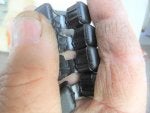Just in the middle of 7k mile service of the Nelli. Valve shims all out, reversed then measured again as they were all dimpled. Following Engenia's xl service plan I decided to whip off the alternator and check the z25 bolt was tight even though I had no starting issues.
Was shocked to find the head of the Z25 bolt and Belville washer fall out onto the crankcase and we all know that is not good!!!! (Polite version)


Took the clutch cover off to inspect likely damage in the clutch area. The z25 shaft was protruding from the post mod z25 gear causing a slight bur on the inner edge of the large clutch basket gear. That would explain the slightly hairy magnet sump plug when I drained the oil.
Lesson learned so far - Pull the alternator off every service and check the z25 retaining bolt and alternator shaft nut.
So I really need some advice from the experts out there
I put a lot of effort into ensuring that all the relevant mods had been done which was confirmed at the 600 mile service - hence worried to find this.
Was shocked to find the head of the Z25 bolt and Belville washer fall out onto the crankcase and we all know that is not good!!!! (Polite version)
Took the clutch cover off to inspect likely damage in the clutch area. The z25 shaft was protruding from the post mod z25 gear causing a slight bur on the inner edge of the large clutch basket gear. That would explain the slightly hairy magnet sump plug when I drained the oil.
Lesson learned so far - Pull the alternator off every service and check the z25 retaining bolt and alternator shaft nut.
So I really need some advice from the experts out there
- Has anyone ever heard of a post mod bolt shearing before?
- What could have caused it to shear - over torqued, fault in bolt metal????
- Can I knock the shaft out from the alternator side with a 13mm bar, leaving the z25 gear in place?
- Should I replace the z25 shaft with new if I can get the remain of the bolt out?
- Finally the worrying question -should the main clutch basket gear have any play - it rocks slightly like when you find wheel bearings goosed? If it shouldn't rock - what is the likely cause?
- Will definitely need the alternator cush drive gear seen in the picture - wonder if they are readily available?
I put a lot of effort into ensuring that all the relevant mods had been done which was confirmed at the 600 mile service - hence worried to find this.













